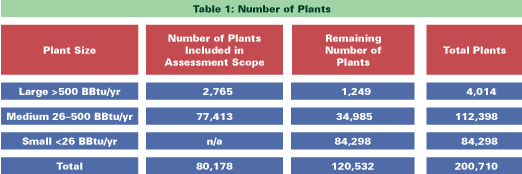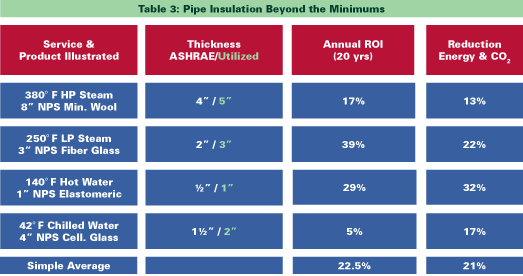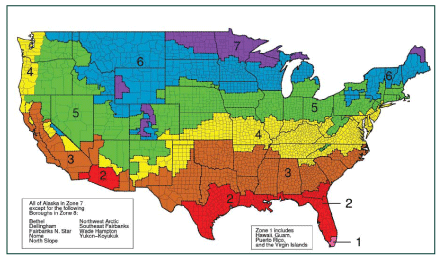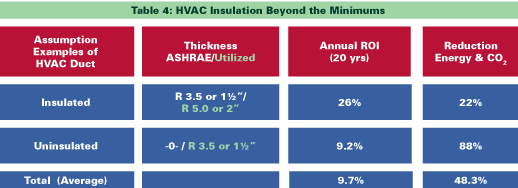Mechanical Insulation Can Save $4.8 Billion in Energy Costs and 43 Million Metric Tons of CO2 Emissions, and Create 89,000 Green Jobs Per Year
For those in the mechanical insulation industry, the information in this article will be the basis for the old cliche “I told you so.” For doubters, recent findings from the Department of Energy should certainly change your perspective as to the value of this proven, but often forgotten, technology.
This article will examine documented benefits of mechanical insulation in the industrial maintenance market and the difference a modest increase in mechanical insulation would make in the industrial and commercial building industries. The time is now to educate everyone about the benefits of properly specifying, installing, and maintaining mechanical insulation. Assess the opportunity in your facility or company and allocate the resources to make it happen.
Analyzing the Benefits of
Mechanical Insulation
Mechanical insulation systems are used for thermal, acoustical, and personnel safety reasons on piping, equipment, vessels, ducts, boilers, and similar mechanical equipment in industrial and commercial applications. Mechanical insulation intersects with a wide variety of industries, from power and process plants to small manufacturing to schools, hospitals, office buildings, etc. Mechanical insulation has never received the same governmental or business attention as the residential sector and more glamorous energy efficiency/emission reduction initiatives. Some reporters have made comments like “mechanical insulation is not an exciting subject” and “it is hard to get people interested,” although it is important to all industries and to our country’s overall goal of energy independence, climate change, and job creation.
The U.S. Department of Energy’s (DOE’s) Industrial Technologies Program’s (ITP’s) mission is to improve national energy security, environment, and economic competitiveness by transforming the way U.S. industry uses energy. Save Energy Now (SEN) is a national initiative of the ITP to drive a 25 percent reduction in industrial energy intensity in 10 years. Companies nationwide can participate in no-cost energy assessments and utilize ITP resources to reduce energy use while increasing profit. The ITP is a great example of how government and private industry can work together on common objectives.
The SEN program has conducted industrial energy assessments since 2006 on potential energy efficiency and conservation opportunities, including mechanical insulation, across many operational disciplines and applications. Based on the depth and breadth of those assessments (over 700 at the time of developing the data in this article), the National Insulation Association (NIA), a long-time partner with the ITP, asked to work with the ITP and Oak Ridge National Laboratory (ORNL) team to mine the findings related to mechanical insulation and to extrapolate that data across the universe of plants included in the ITP assessments.
The SEN mechanical insulation assessments were primarily focused on process heating and steam systems under existing conditions within the various facilities. Accordingly, the assessment results do not represent the total energy or emission reduction potential for those plants, and the findings can best be characterized as industrial insulation maintenance opportunities.
The analysis’ objective was to determine the potential of mechanical insulation-related energy savings, greenhouse gas emission reduction, and job creation within the plant universe focused on by the ITP.
- The plants were segregated into three size categories:
- Large Plants— >500 BBtu/yr. Assessments were conducted by independent assessors approved within the SEN program. The power/utility industry segment was not included.
- Medium Plants—using 26?500 BBtu/yr. Assessments were conducted by the ITP’s Industrial Assessment Centers (IAC).
- Small Plants—using
- The numbers of plants by the size categories were determined from the 2002 Energy Information Administration (EIA) Manufacturing Energy Consumption Survey (MECS-2002). Those plants were then subdivided into those included in the focus of the ITP assessments and those that were not (apparel, leather and allied products, printing, and furniture).
- Assessment results were then extrapolated over the total number of plants within the large and medium plant categories.
- NIA estimated the annual return on investment (ROI) based on a simple calculation over a 20-year life with 3 percent annual energy cost escalation.
- NIA estimated the value for the small plant category based on an assumption of value relative to the medium plant category.
- The assessments included an estimated payback in months. NIA used that information for a series of calculations to estimate the number of jobs that could be created or preserved. Products for the mechanical insulation industry flow through the distribution channel; accordingly, NIA was also able to estimate the job impact on that channel.
These impressive numbers are supported by the findings of over 700 assessments in the large and medium plant category. And they illustrate only a portion of the opportunity in the industrial maintenance market. Similar opportunities in the commercial industry are not included in the analysis.
ORNL’s Dr. Anthony Wright, an expert on energy efficiency best practices, said, “Many of the large and medium plant energy assessments sponsored by the U.S. Industrial Technologies Program have identified mechanical insulation improvements as an important savings opportunity. Improvements in mechanical insulation in large and medium U.S. industrial plants are often a cost-effective opportunity for reducing energy use and energy costs and should be seriously considered.”
To put the $2.5 billion in energy savings in context, President Obama’s goal is to save $2 billion per year from increasing energy efficiency in government buildings using all technologies combined.
What would a similar analysis show for the public utility/power industry? NIA is still refining that estimate, but preliminary findings indicate the potential of an additional $1.1 billion per year in energy savings, 10 million metric tons in CO2 emission reduction, and creating or preserving an additional 12,568 jobs—with a payback in 17.2 months or 73 percent annual ROI.
The Challenges of Implementation
Mechanical insulation maintenance is an unprecedented opportunity for energy efficiency, improving carbon footprint, improving the bottom line, and stimulating our economy with the creation of “green jobs.” That is a winning combination that should not be overlooked at any level, either the board room or the operating floor.
The additional benefits of maintaining mechanical insulation systems in a proper and timely manner have not been considered in this analysis. Those benefits include personnel safety, helping prevent corrosion under insulation and the development of mold, increased plant productivity, and extending the life of equipment. If the energy and emission reduction benefits were not compelling enough, these benefits should make companies ask: why has mechanical insulation been overlooked or put on the back burner, and how can we immediately implement plans to take advantage of this technology?
As a general rule, mechanical insulation systems are not being maintained in a timely and proper manner. This is why 10 to 30 percent of installed mechanical insulation systems are estimated as being damaged or missing within a few years of initial installation. The ITP assessments to a certain extent validate those findings.
An investment in mechanical insulation maintenance, if avoided or delayed, could cost much more than the initial investment. In many companies, mechanical insulation maintenance is viewed as a short-term expense versus an investment, even though the return is in many cases less than a year.
To take full advantage of mechanical insulation, it is essential to begin thinking differently about mechanical insulation and the value it can provide. While mechanical insulation is not an exciting topic, it is a resource that, when all the benefits are considered, should prompt the question: “Why haven’t we thought of this before?”
Going Beyond the Minimums:
New Construction
The most widely accepted benefit of mechanical insulation is energy savings. In new construction, it would be logical to assume the specifications have taken into consideration “economic thickness” calculations. However, that assumption could be dangerous. The cost of energy has increased substantially over the last 10 to 20 years, but in many cases the insulation specification has not kept pace. But, for the sake of discussion, let us assume current specifications have taken energy cost increases into consideration.
No single mechanical insulation thickness standard or guideline is recognized across the U.S. commercial and industrial markets. There are many excellent publications; however, ASHRAE 90.1 2004 or 2007 is the most recognized standard or guideline for the commercial market. ASHRAE 90.1 2007 includes tables reflecting minimum values or thicknesses for mechanical insulation. Section 6-Subsection 6.4.4.1 addresses insulation. Tables 6.8.2A and B assign minimum R-values for duct and plenum insulation, while Table 6.8.3 provides minimum thicknesses for pipe insulation. Again, for the sake of discussion, assume all specifications are based on the minimum requirements established by these ASHRAE tables.
The question then becomes: If you went reasonably beyond those minimums, what would be the impact? What if your primary objective was energy efficiency and the environment, and the economical thickness methodology came second?
It is important to note that while many codes and standards reference the levels established in ASHRAE 90.1, those minimum levels are not necessarily installed. Often “value engineering” alternatives are accepted and/or the ASHRAE standards are interpreted or applied incorrectly. Also, the ASHRAE standards are not universally recognized in the industrial market segment; thus, the minimum level may not be observed in those applications.
Going beyond the minimums is a real and viable alternative that should be considered. However, when examining and determining the final thickness/thermal performance recommendation for the insulation system(s), code compliance and competitive impact on the overall industry should be considered in addition to the energy and environment benefits.
Going Beyond the Minimums: Pipe Insulation
Through an informal survey of several insulation manufacturers, it was determined 370 million linear feet of pipe insulation is sold annually (2009 estimate) into the commercial and industrial markets. Several assumptions needed to be made for this analysis:
- The piping market is equally divided into four operating conditions.
- Determine a representative pipe size within each of the operating conditions.
- Determine an insulation product/system for each operating condition, although each has multiple excellent system options. The products selected do not indicate a preference or recommendation for those products in those applications. They were simply chosen for illustrative purposes. Alternative insulation systems could be used in these examples with differing results.
Based on these assumptions, the impact of increasing insulation thicknesses above the ASHRAE minimums exceeded expectations and should be considered.
This simple analysis yields the potential of more than $302 million annually in energy savings, the reduction of 1.5 million metric tons of CO2 emissions, and the creation of more than 2,000 jobs.
Going Beyond the Minimums: Heating, Ventilating, and Air Conditioning (HVAC) Insulation
Using the same approach with HVAC was not quite as easy. The ASHRAE HVAC insulation selection process includes considering seven climate zones (see Figure 4), four types of service, and seven different duct locations. The assumptions were:
- Climate Zone 5 would be used for all examples.
- The existing “insulated” duct would be “dual service” (heat/air conditioning) and be in an “unconditioned space.”
- The “un-insulated” duct would be “dual service” (heat/air conditioning) and be in an “indirect conditioned space.”
- Although several different products could be used, for simplifying purposes one insulation system was selected. The system selected does not indicate a preference or recommendation for that system in those applications. It was simply chosen for illustrative purposes. Alternative insulation systems could be used in these examples with differing results.
As with pipe insulation, an informal survey determined that 2.7 billion square feet of duct is installed annually (2009 numbers) and, of that, approximately 72 percent is not being insulated. Based on that information and the assumptions, the impact if insulation thicknesses were marginally increased over the ASHRAE minimums was determined. The results far exceeded expectations.
The HVAC insulation analysis yields annually more than $900 million in energy savings, the reduction of 4.3 million metric tons of CO2, and the creation of more than 60,000 jobs.
The Bottom Line
These examples illustrate the huge energy efficiency opportunity in the industrial and commercial sectors: $4.8 billion in energy savings, a reduction of 43 million metric tons of CO2 emissions, and 89,000 new jobs. The CO2 reduction would be the equivalent of shutting down nine coal plants.
Mechanical insulation maintenance does not require research or an extensive engineering process. The scope can be identified, an RFQ issued, and the work initiated in weeks. It is truly “shovel ready” and pays for itself over and over again.
If we are serious about long-term energy independence, climate change, and a recovering economy, we need to think about insulation differently when it comes to examining minimum guidelines or traditional approaches. Even a modest increase can have a significant impact. As our country continues to examine all forms of new energy and improving existing technologies, we should not forget proven energy efficiency/conservation and emissions reduction technologies. Mechanical insulation is one of those technologies, although it has long been forgotten or overlooked.
The findings discussed in this article should create a “red alert” in facilities and companies, at code and regulatory agencies, and at all levels of government to examine the mechanical insulation opportunities right in front of them.
Every day we hear about the energy efficiency and emissions reduction benefits of lighting, windows, envelope insulation, solar panels, wind turbines, etc. Those initiatives should be explored, but what about mechanical insulation? It has been around for centuries and is proven, ready now, and on a dollar-for-dollar basis a better value than many other initiatives that get all the press coverage and attention of federal, state, and local officials. The time is now to educate everyone about mechanical insulation, assess the opportunity, and allocate the resources to make it happen.
A special note of appreciation is extended to Bill Orthwein with the DOE’s ITP and Dr. Anthony Wright and Sachin Nimbalkar with ORNL for their commitment and support in helping mine the large and medium plant data from the ITP assessments, as well as to Chris Crall for his work helping develop the “Going Beyond the Minimum” estimates and to all the insulation manufacturers who assisted in the informal surveys.
Note: Some of this data was derived using ASHRAE tables and 3E Plus.





